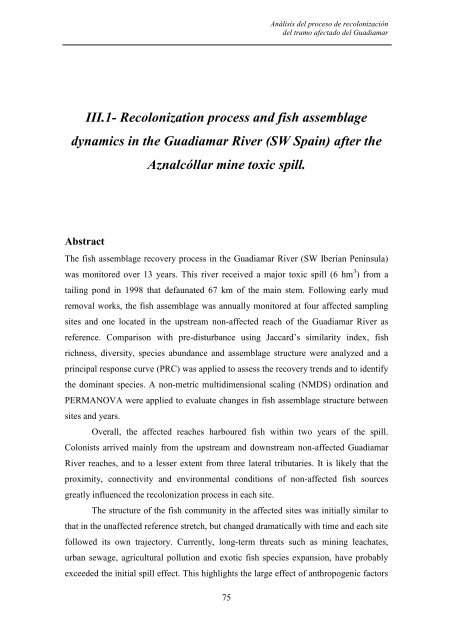las comunidades de peces del río guadiamar y el accidente minero ...
las comunidades de peces del río guadiamar y el accidente minero ...
las comunidades de peces del río guadiamar y el accidente minero ...
Create successful ePaper yourself
Turn your PDF publications into a flip-book with our unique Google optimized e-Paper software.
Análisis <strong>de</strong>l proceso <strong>de</strong> recolonización<br />
<strong>de</strong>l tramo afectado <strong>de</strong>l Guadiamar<br />
III.1- Recolonization process and fish assemblage<br />
dynamics in the Guadiamar River (SW Spain) after the<br />
Aznalcóllar mine toxic spill.<br />
Abstract<br />
The fish assemblage recovery process in the Guadiamar River (SW Iberian Peninsula)<br />
was monitored over 13 years. This river received a major toxic spill (6 hm 3 ) from a<br />
tailing pond in 1998 that <strong>de</strong>faunated 67 km of the main stem. Following early mud<br />
removal works, the fish assemblage was annually monitored at four affected sampling<br />
sites and one located in the upstream non-affected reach of the Guadiamar River as<br />
reference. Comparison with pre-disturbance using Jaccard’s similarity in<strong>de</strong>x, fish<br />
richness, diversity, species abundance and assemblage structure were analyzed and a<br />
principal response curve (PRC) was applied to assess the recovery trends and to i<strong>de</strong>ntify<br />
the dominant species. A non-metric multidimensional scaling (NMDS) ordination and<br />
PERMANOVA were applied to evaluate changes in fish assemblage structure between<br />
sites and years.<br />
Overall, the affected reaches harboured fish within two years of the spill.<br />
Colonists arrived mainly from the upstream and downstream non-affected Guadiamar<br />
River reaches, and to a lesser extent from three lateral tributaries. It is lik<strong>el</strong>y that the<br />
proximity, connectivity and environmental conditions of non-affected fish sources<br />
greatly influenced the recolonization process in each site.<br />
The structure of the fish community in the affected sites was initially similar to<br />
that in the unaffected reference stretch, but changed dramatically with time and each site<br />
followed its own trajectory. Currently, long-term threats such as mining leachates,<br />
urban sewage, agricultural pollution and exotic fish species expansion, have probably<br />
excee<strong>de</strong>d the initial spill effect. This highlights the large effect of anthropogenic factors<br />
75

















